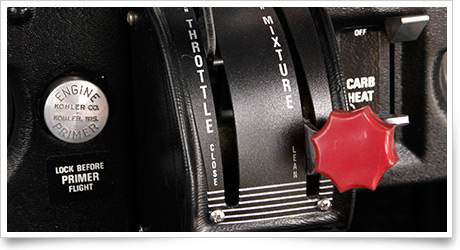Custom content for the Nov. 23, 2012, issue of 'AOPA ePilot' newsletter
| The following stories from the Nov. 23, 2012, edition of AOPA ePilot were provided to AOPA members who expressed an interest in the particular subject areas. Any AOPA member can receive information tailored to their areas of interest by updating their preferences online |
training tipsA prime directive
Procedures for cold-weather engine starts vary by make and model—but how well the pilot understands the details of starting technique often determines who flies and who only tries.
For example, priming a carbureted engine may seem like a simple task, but the right touch will deliver results that let you get on with your session.
Why is priming key in the cold?
Chapter 6 of the Pilot's Handbook of Aeronautical Knowledge explains that “during cold weather, when engines are difficult to start, the fuel primer helps because there is not enough heat available to vaporize the fuel in the carburetor.”
That’s the key operating principle. But what’s so touchy about start-ups that a pilot’s priming know-how can make such a big difference?
The Air Safety Institute’s Safety Advisor on engine operations addresses that question: “On carbureted engines, cold starts are arguably the most difficult and provide a test of the pilot’s understanding of aircraft systems,” it says. “To start a cold engine, add extra fuel by priming. This puts fuel directly into one or more cylinders (via the intake manifold). Refer to the aircraft’s POH (pilots operating handbook) for the correct priming technique. Do not pump the throttle, as this will simply force raw fuel (which doesn’t vaporize as easily in cold weather) into the intake system, possibly causing an engine fire.”
Don’t rush when applying your priming strokes. Often you can hear the faint hissing noise of the primer doing its work.
As noted, how much to prime is a matter of a specific make and model’s recommended procedures. If a range of priming strokes to apply is published for your aircraft, keep in mind that the colder the temperature, the more you may have to prime.
Up and running? Don’t move on to the next checklist item without making sure that the primer is locked securely in place. Should an unsecured primer work loose, or be left partly extended, your trainer’s engine might be running excessively rich. That condition might leave your aircraft unable to deliver maximum power when needed. training productsSporty’s flight tests iPad MiniThe team at Sporty’s received the iPad Mini and put it through its paces. Sporty’s loaded it up with popular aviation apps, including ForeFlight Mobile, Garmin Pilot, and WingX Pro. “We were immediately impressed with the overall build-quality of the iPad Mini, and it feels as solid and well-constructed as the larger iPad models,” Sporty’s wrote. “The smaller tablet means less weight to lug around in your flight bag and allows for more mounting options than were previously available with the regular iPad.” Cessna, King Schools offer sport/private courseCessna has worked with King Schools to offer a scenario-based flight training course. The Web-based course is for the pilot who is training in either a technically advanced, full-glass-cockpit airplane or in an airplane with analog gauges. The training includes videos and full-motion diagrams of the course material, plus a complete FAA knowledge exam review program—and it’s available anywhere with Internet access.
Note: Products listed have not been evaluated by ePilot editors unless otherwise noted. AOPA assumes no responsibility for products or services listed or for claims or actions by manufacturers or vendors. final examQuestion: If I perform the required takeoffs and landings for carrying passengers at night, does that mean I'm current to carry passengers during the day?
Answer: Yes, as long as the night landings were completed in the same category, class, and type of aircraft you plan to fly during the day. FAR 61.57 provides the recency of experience requirements for acting as pilot in command. To carry passengers during the day, you must have completed three takeoffs and three landings as sole manipulator of the controls in the same category, class, and type (if a type rating is required) within the preceding 90 days. The landings must be completed to a full stop if they are done in a tailwheel airplane. To carry passengers at night, all of the same day requirements apply. In addition, the landings, regardless of the airplane you're flying, must be done to a full stop during the period beginning one hour after sunset and ending one hour before sunrise. For additional information on currency, read this legal briefing.
Got a question for our technical services staff? Email [email protected] or call the Pilot Information Center, 800/872-2672. Don’t forget the online archive of “Final Exam” questions and answers, searchable by keyword or topic. |
 It’s a chilly morning out on the flight line. Whether it’s cold enough to require an engine preheat or not, you may have noticed that not everyone who got out there for an early-morning practice session has managed to start up and taxi away without difficulty.
It’s a chilly morning out on the flight line. Whether it’s cold enough to require an engine preheat or not, you may have noticed that not everyone who got out there for an early-morning practice session has managed to start up and taxi away without difficulty.

